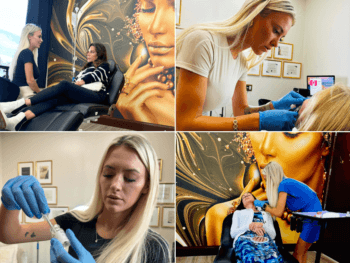
We take a closer look at the popular destination for cosmetic procedures.
Medical Spas, or medi spas, offer anything from facials to pharmaceutical injections to a host of other medical procedures. They can be found in physicians’ offices as well as in shopping malls and beauty salons.
In the U.S. alone, medi spas have grown from 800 in 2007 to around 4,500 today and, according to the International Medical Spa Association, they continue to pop up at rapid speed as technology improves, allowing for better results from less invasive cosmetic procedures with a lot less downtime.
“Older people remaining in the workforce sometimes want to look younger than their years, but don’t want to take weeks off their job to recover from a facelift. So they’re turning to medical spas to smooth their wrinkles and erase their age spots,” says Dr. Timothy C. Flynn, president of the American Society for Dermatologic Surgery Association.
Medi spa can be a misleading term though, because when we think spa, we think body wraps, aromatherapy and specialty baths in a safe environment where we’re being pampered. But a medical spa is different and it’s important to do your homework before going to one of these places for a skin enhancing treatment or to have something removed, because there’s very little that’s medical about some of them.
 It’s not uncommon to find places that offer injectables, laser treatments and other services that are traditionally done at a dermatology clinic. Although these places are convenient and offer seductive discounts, either through Groupon or through their own discount days, consumers should do their research when choosing a medi spa.
It’s not uncommon to find places that offer injectables, laser treatments and other services that are traditionally done at a dermatology clinic. Although these places are convenient and offer seductive discounts, either through Groupon or through their own discount days, consumers should do their research when choosing a medi spa.
Medi spas are not regulated so they’re not held to the same level of accountability and safety standards as a regulated facility, such as a dermatology clinic, where the staff is under scrutiny by the government. And remember, just because a spa is affiliated with a doctor, it doesn’t mean the doctor is available if anything goes wrong.
The American Society for Dermatologic Surgery suggests asking questions such as, what kind of training and qualifications does the aesthetician have and what technology and/or products do you use? When Botox is administered by unqualified or inexperienced practitioners there’s risks such as droopy eyelids or paralysis of breathing and swallowing muscles. Laser treatments given by unqualified technicians can permanently mark your skin or damage your eyes.
The American Society for Aesthetic Plastic Surgery advises to never allow a non-medical, unlicensed person to perform a medical procedure and to be sure that the procedure is supervised by a physician board-certified in plastic surgery or dermatology. Injectables (such as Botox and tissue fillers), skin treatments (such as laser, intense pulse light and radiofrequency), and deep peels should be performed under the supervision of board-certified plastic surgeons or dermatologists. You should ask what the protocol is if something happens as a result of your treatment and is there a doctor on site and accessible.
It’s your body, so protect your health and ensure an optimal outcome because even generally safe procedures have real risks.
BY GAIL TRAVERS
PUBLISHED IN THE HEALTH & WELLNESS ISSUE/SUMMER 2014














































































































